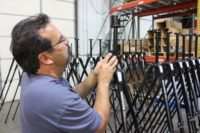But in addition to the materials, we always make it a priority to showcase the manufacturing process, and understanding this process can be critical for fabricators.
Whether a fabricator is importing directly or buying through their local distributors, they should understand the process that was used for creating the slabs that they will be cutting. Some terrific developments have taken place in terms of slab processing, but it is not only the level of technology in place, but also the overall process.
Here is just a sample of what I am looking for at a slab-processing plant.
- How is the plant cutting their blocks into slabs? Are they using gangsaws? Have they upgraded to multi-wire saws? Either one is fine, but a plant with multi-wire saws might have some expanded product selections in terms of slab thickness.
- Are the blocks being trimmed before processing?
- In addition to applying resin products automatically, do they have a system in place for applying resin by hand for certain exotics that may require it? Are they using resin products from a proven manufacturer of these products?
- How much block inventory do they have? Do they have a good inventory of their "exclusive" materials?
- What level of polishing technology is in place? What type of abrasives are they using?
For those of us not lucky enough to get to Brazil or Italy each year, these are questions that can be posed to your importer/distributor. They should know -- or at the very least, they should be able to find out. You might not need to be asking these questions for every material you buy, but it might be a good idea when working with certain materials. It is very important for me to point out here that there is not a single model that defines the "best" slab producers, because plants have different machinery and methods for different levels of materials. I can say that some of the most efficient slab producers in the world rely on gangsaws, and many plants known for "standard" materials rarely (if ever) need their resin products applied by hand. As part of our lineup of articles in Stone World, we regularly showcase as many slab producers as we can in our print and online editions, including two Brazilian companies in the "How-To" section of this ENewsletter. I know it's not the same as actually going to Brazil and enjoying a Caipirinha or two in the evening, but at least you get to see the manufacturing process.




